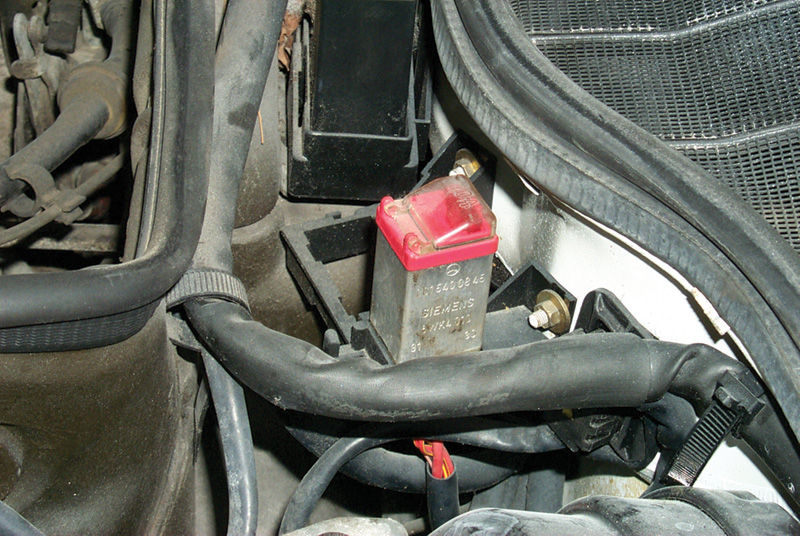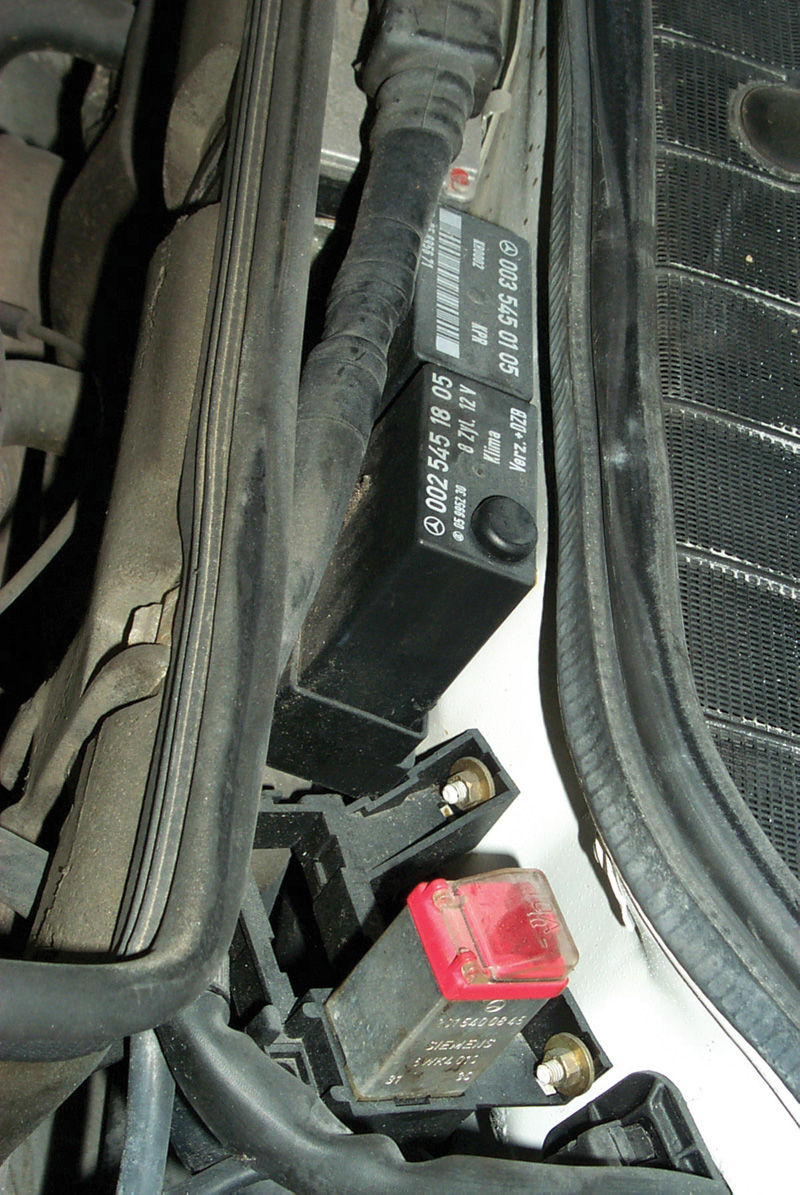Two little boxes a Mercedes-Benz carries, and what’s inside.
Most Mercedes-Benz cars carry under their hoods a pair of relays not found on other cars, the overvoltage protection relay and the Klima relay. Both of them serve to protect different components of the fuel, ignition and climate control systems under various circumstances, and both of them play important roles in various other vehicle systems. These relays ordinarily function to toggle electric power to the engine systems control unit (MAS) and to the electronic ignition control unit (EZL), but in some cases of very high or sustained overcharge, reversed polarity and the like, they burn out themselves rather than conveying the high current to the control units. In those cases, of course, find the source of the spike first before replacing the sacrificed relay.
 Overvoltage Protection Relay
Overvoltage Protection Relay
 The overvoltage protection relay, usually found with a red top and a fuse under the plastic cover, keeps voltage surges from damaging critical and sensitive ignition and fuel system components, particularly relays and modules. Voltage spikes can come from causes internal to the vehicle, such as a defective voltage regulator that full-fields the alternator’s rotor windings, or from external sources, such as an attempted jump start from a vehicle with the wrong system voltage or a jump with reversed polarity. If you find a Mercedes-Benz with no spark or no fuel, before you begin lengthy diagnoses of those systems, check the fuse atop the overvoltage protection relay and the relay itself (which can have its contacts fused closed or its coils burned open by a sufficiently high overvoltage surge).
The overvoltage protection relay, usually found with a red top and a fuse under the plastic cover, keeps voltage surges from damaging critical and sensitive ignition and fuel system components, particularly relays and modules. Voltage spikes can come from causes internal to the vehicle, such as a defective voltage regulator that full-fields the alternator’s rotor windings, or from external sources, such as an attempted jump start from a vehicle with the wrong system voltage or a jump with reversed polarity. If you find a Mercedes-Benz with no spark or no fuel, before you begin lengthy diagnoses of those systems, check the fuse atop the overvoltage protection relay and the relay itself (which can have its contacts fused closed or its coils burned open by a sufficiently high overvoltage surge).
The Klima Relay
 The Klima relay, marked with the word Klima somewhere among the numbers on the top, has inputs from the crankshaft position sensor and from the air conditioning compressor speed sensor, on the back end of the compressor crankshaft. If the ratio between these two signals falls outside the correct ratio determined by the relative pulley sizes, this relay disconnects power to the compressor clutch for the remainder of that trip. Why? Because if those signals don’t correspond to that ratio, the discordance indicates the serpentine accessory drive belt is slipping, the clutch is slipping or the belt is broken. Since the accessory drive belt turns other components, including some like the water pump and alternator that are more important to the running of the vehicle than the air conditioning compressor, the Klima relay cuts the circuit to unload the compressor, relieve the load on the belt and, hopefully, avoid a broken or slipping drive belt and the various unhappy consequences that can have for the motorist. On most models, the Klima relay will reset for the next trip and will allow at least a momentary engagement of the air conditioner clutch to retest for belt slip. This initial re-engagement can provide you a diagnostic clue if you take the trouble to watch the compressor pulley just as someone turns on the air conditioning for the first time in a given startup.
The Klima relay, marked with the word Klima somewhere among the numbers on the top, has inputs from the crankshaft position sensor and from the air conditioning compressor speed sensor, on the back end of the compressor crankshaft. If the ratio between these two signals falls outside the correct ratio determined by the relative pulley sizes, this relay disconnects power to the compressor clutch for the remainder of that trip. Why? Because if those signals don’t correspond to that ratio, the discordance indicates the serpentine accessory drive belt is slipping, the clutch is slipping or the belt is broken. Since the accessory drive belt turns other components, including some like the water pump and alternator that are more important to the running of the vehicle than the air conditioning compressor, the Klima relay cuts the circuit to unload the compressor, relieve the load on the belt and, hopefully, avoid a broken or slipping drive belt and the various unhappy consequences that can have for the motorist. On most models, the Klima relay will reset for the next trip and will allow at least a momentary engagement of the air conditioner clutch to retest for belt slip. This initial re-engagement can provide you a diagnostic clue if you take the trouble to watch the compressor pulley just as someone turns on the air conditioning for the first time in a given startup.
In later models, the function of the Klima relay is assigned to the updated MAS control unit, essentially a complex relay providing power to the fuel pump, ignition system and other critical components. Like the Klima relay, it compares rpm between the compressor and the engine crankshaft and disconnects the clutch if they don’t match correctly. The MAS unit, however, controls many other electrical and electronic functions, which we’ll cover another time.






0 Comments